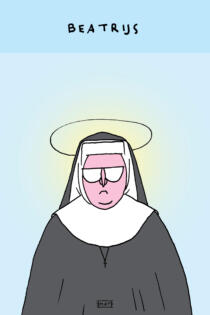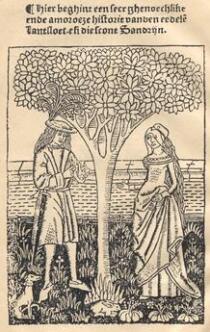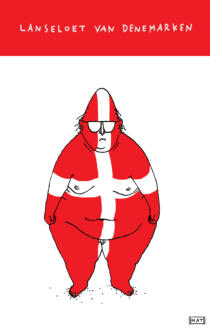What she had always feared proves to be true seven years later: the money is gone and she is abandoned with her two children. She works as a prostitute for seven years, but then she repents. She wanders about begging, with a child in each hand, until one day she finds herself in the neighbourhood of her former convent. In a vision, she learns that Mary had taken on her form and replaced her in the nunnery. And so Beatrice can pick up the thread of her former life unnoticed.
The rhyming, Middle Dutch Beatrice was not that popular in the Middle Ages. Only one manuscript has been preserved, dating from 1374, possibly from the Brussels area. However, many stories from all over Europe about a runaway sextoness who is able to return to her convent thanks to Mary, have survived. The oldest of these “Sacristan legends” can be found in the work of the 13th-century monk Caesarius van Heisterbach. He wrote “De Beatrice custode” (“about the sacristan Beatrice”) above one of these short stories, which mainly served as a subject around which to build a sermon.
The Middle Dutch Beatrice owes its literary triumph to the W.J.A. Jonckbloet publication in 1841. Writers, academics and researchers recognised its qualities: the rhythm of the verses, the graceful dialogues, the fine psychological characterisations and the seemingly simple yet ingenious structure, full of mirror images. Only the ending displeased, in which Beatrice learns from a vision that she must still confess her sins. For a long time, it was assumed that this was a later addition to the poem.
In 1896, the art and literature magazine The Pageant published a prose translation of Beatrice in English. This translation formed the basis of international interest in the story of the escaped sextoness. Maurice Maeterlinck, who would go on to win a Nobel prize, used it for his play Sister Beatrice, which filled theatres all over Europe. In 1911, the successful mass spectacle The Miracle followed, which was turned into a film one year later. Authors like P.C. Boutens and Herman Teirlinck rushed to come up with their own adaptations.
The popularity of Beatrice reached its peak during the interwar years, but interest did not entirely wane afterwards. Writers including Gabriël Smit, Karel Jonckheere and Willem Wilmink challenged themselves to produce rhyming translations. Ed Franck and Agave Kruijssen created prose adaptations for young people. In 2012, there was even a Hungarian translation in verse. But the most remarkable reworking of recent years must be the theatre piece Beatrix, which has been performed by the African singer and actor LieSl Marx since 2011. She created a moving monologue about love and forgiveness against the backdrop of the hard facts about prostitution in South Africa.






